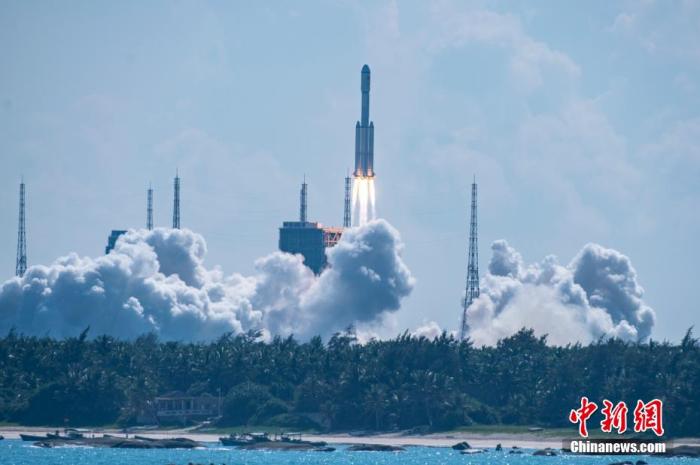China News Service, Beijing, September 20 (Ma Shuaisha, Zheng Yingying, Li Tong) The Long March 7 Yaosi carrier rocket was successfully launched on the 20th at the Wenchang Space Launch Site in China with the Tianzhou-3 cargo spacecraft.
Tianzhou-3 is the second cargo spacecraft launched during the construction phase of China's space station. How is it different from Tianzhou-2? How the Tianhe core module docks with two cargo spacecraft at the same time arouses people's curiosity.
Two "courier brothers" appeared on the space station
On May 29, the Long March 7 Yaosan launch vehicle carried the first cargo spacecraft of the China Space Station, Tianzhou-2, towards the Tianhe core module and successfully docked at the rearward port.
How can the core compartment of a backward port dock with two cargo spacecraft at the same time?
The picture shows the moment when the Long March 7 Yao-4 launch vehicle ignites.
Photo by Luo Yunfei
On September 18, the Tianzhou-2 cargo spacecraft, which had been in orbit for more than 100 days, was turned on and separated from the space station’s sky and core compartment to the rear port, and flew to the forward port to complete the automatic rendezvous and docking, thus giving way to the rearward pair. The interface is ready for the Tianzhou-3.
With the realization of autonomous and rapid rendezvous and docking of the Tianzhou-3 and the core module of the space station and the Tianzhou-2 combination, the China Space Station will have two "courier brothers" visiting, respectively located at the forward and backward ports, forming the word "one" Configuration, waiting for 3 astronauts from Shenzhou 13 to come to the space station.
What is the difference between "Brother Express" No. 2?
Simply put, the Tianzhou cargo spacecraft can be divided into a cargo compartment and a propulsion compartment. The astronauts' living supplies and other scientific experiment equipment are neatly placed in the cargo compartment.
It is understood that compared with the Tianzhou-2 cargo spacecraft, the Tianzhou-3 cargo spacecraft carries 25% more cargo, including three people’s 6-month life consumables, and a set of extravehicular space suits, which can satisfy the following 3 requirements. 6 months of livelihood security for astronauts on a "business trip".
According to the propulsion module assembly designer of the 805 Institute of the Eighth Academy of China Aerospace Science and Technology Corporation, the propellant storage tanks of the Tianzhou-3 cargo spacecraft were reduced from 8 to 4, and only the Tianzhou-2 was carried. Half of the fuel.
Why do you carry more cargo but take less propellant by nearly half?
“Tianzhou-2 carried 3.5 tons of fuel to refuel the core compartment of the sky and the core. At present, the core compartment requires sufficient fuel to ensure normal operation in orbit. Therefore, the Tianzhou-3 is in order to increase the single ship of the cargo spacecraft. After many demonstrations on the engineering benefits of flying missions, we decided to bring more cargo and less fuel.” The designer said.
In addition, the rear end of the cargo compartment is connected to another important section of the cargo spacecraft-the propulsion compartment.
If the Tianzhou cargo spacecraft is the "logistics support force" of the entire space station system, then the propulsion module is the "energy system" of the cargo spacecraft.
On the one hand, the propulsion module provides flight power for the spacecraft itself, and on the other hand provides on-orbit fuel replenishment for the space station’s sky and core modules.
At the same time, the two pairs of solar battery wings installed outside the propulsion cabin provide continuous power transmission for the spacecraft and ensure the normal operation of the entire ship's power system.
It is understood that during the construction phase of the space station, China will arrange four cargo spacecraft to "add bricks and tiles" to the space station, and set up a lifeline for material protection between the sky and the earth.
(over)

